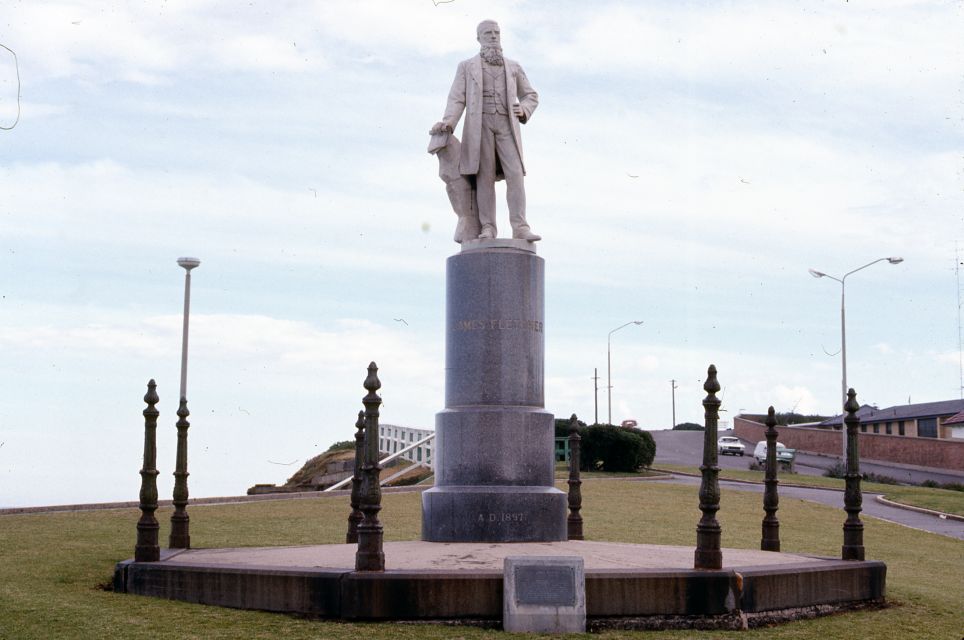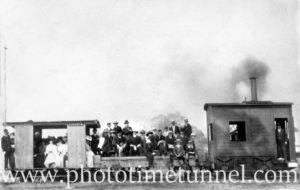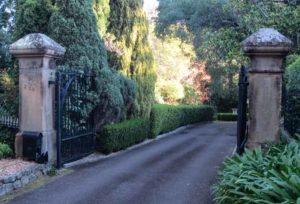My late friend and amateur historian Dulcie Hartley published several books during her lifetime, but one book she was very proud of never made it into print. This was her book about James Fletcher, Newcastle’s famous “miners’ advocate” – the only man in the city to be commemorated with a statue. Miner, politician and newspaper proprietor, Fletcher was immensely popular and influential, and Dulcie was fascinated by him. After Dulcie’s death, her daughter Venessa entrusted me with the manuscript, and I have slowly transcribed it.
What follows are the preface and first chapter of Dulcie’s six-chapter work.
Preface
This work does not seek to present a definitive political statement of James Fletcher’s era. It seeks to document him in his political context and in his roles of coalminer, mine manager, mine proprietor, newspaper proprietor and member of parliament. He has been eulogised as the miners’ friend and the miners’ advocate and more of his role in the mining industry is documented in Book Two, The formation of the New South Wales Cooperative coal mining company, 1861 to 1925.
Some glimpses of his private life were sourced from his scrapbooks – still held by family members. Instances where a political newspaper cutting was pasted next to a remedy for rheumatism were rewarding, as was the letter – still attached by pin – from Sir Henry Parkes. His later upward social mobility resulted in residence and ownership of the home Icasia at Waverly. After his death the home and contents were advertised for auction in The Sydney Morning Herald. The advertisement – taking one whole column of the newspaper – revealed an opulent lifestyle enjoyed by the Fletcher family in his latter years. He had stated earlier in his career that men should strive through education and effort to improve their situation in life and he pursued this aim.
During the early years of his political career James Fletcher supported the free traders. However in 1886 he became firmly aligned with the protectionist party and continued so until his untimely demise in March 1891. In the 1880s political parties were in a state of flux. The Free Trade and Liberal Association of New South Wales was formed in 1889. The protectionists became aligned with the newly formed Labor Party during the election of October 1891 (after Fletcher’s death) but the Labor Party continued to remain divided over the issue of protection. The 1891 election resulted in the protectionists gaining 51 seats, the Labor Party 35 and Parkes’s Free Trade Liberals 47. George R. Dibbs, the leader of the Protection Party, formed a Protection Labor ministry. Had Fletcher survived he would ultimately have had to make a choice between the Protection Party and the newly formed Labor Party. It seems likely that he would have continued to support the protectionists led by his old friend and business associate G.R. Dibbs. As it happened, the economic depression of the 1890s resulted in financial adversity for then Sir George Dibbs, who as a result resigned from parliament on August 2nd, 1894.
Fletcher was passionate about many causes: free education, electoral reform and social equity were prominent on his agenda. Also high on the list was a desire to see Newcastle treated fairly by the Sydney-centric government of the day. Even in the 1870s the Hunter Region was the great wealth-producing hub of New South Wales, but the residents complained that little wealth was returned by Sydney interests who disregarded complaints that Newcastle residents had no water supply, no sewerage, poor parks and other inconveniences that would never have been tolerated in Sydney. These problems created a vast agenda for Fletcher’s political career.
Dulcie Hartley, March 1992, (revised on July 2013)
CHAPTER 1: THE EARLY YEARS
Dramatically situated in isolation, a statue stands silhouetted against the skyline in Fletcher Park, Watt Street, Newcastle. Larger than life size, this well-preserved marble effigy of James Fletcher has, for over a century, gazed with unseeing eyes over the city of Newcastle. A plaque mounted at the base reads:

Fletcher – 1834 – 1891
Statue erected by Public Subscription in 1897 to commemorate James Fletcher as a Friend of the Miners. He was Chairman of the First District Miners’ Union in 1861- Manager of the Co-operative
Mine at Plattsburg – A Founder of the Newcastle Morning Herald in 1876 – M.L.A. for Newcastle
1880-1891- N.S.W. Minister for Mines 1886- N.S.W. Minister for Public Works 1889.
In 1897, at the time of the unveiling, there was no need for a plaque, so well-known was the man and his achievements. Nevertheless, with the passing of the years memories fade. In 1967 it was decided to provide a plaque detailing James Fletcher’s achievements as above. As this was for more than a century the only representational statue in the city of Newcastle, it begets the question: What manner of man was James Fletcher to arouse such regard and affection?

James Fletcher was born on 31 August, 1834 at Aberlady, East Lothian (formerly Haddingtonshire), about 16 miles from Edinburgh, Scotland, and was the son of William and Anne (nee Crawford). He was 17 when he arrived in Australia in October 1851, lured by news of recent gold discoveries.
Fletcher had formerly lived at Dalkeith, just south of Edinburgh. This East Lothian district is regarded as the birthplace of the Scottish coal industry, a trade Fletcher is reputed to have followed in his early years. After his arrival in Sydney he humped his swag over the Blue Mountains to the Ophir goldfields where he tried his luck. How successful this venture proved is unknown, but for the remainder of his life he was smitten with gold fever and it was eventually to be partly responsible for his financial woes at the time of his death.
Fletcher’s stay on the goldfields was of short duration for by 1854 he had arrived in Newcastle and was living with Mr and Mrs James Birrell at The Pottery, Burwood, on the coastal estate owned by Dr James Mitchell. At this time there were several coal mines in operation on Mitchell’s property. Alexander Brown had leased land for a mine, as had John Nott, James and Alexander Brown, William and John Donaldson, Newcastle Coal and Copper Co. and Filgate and Co. [1] It is likely that James Fletcher and James Birrell were both working at the Burwood mines, with Birrell probably employed as an overman.
Fletcher courted young Isabella Birrell and on 24 May 1854 the youthful couple were married in the Burwood Presbyterian Church by the Reverend James Nimmo. The following year 21-year-old Fletcher became a father, with the birth of a daughter, Mary Anne, at Burwood.
There was news of further rich strikes on the goldfields and the young family headed over the mountains to the harsh life of the boisterous mining camps. In 1857 Isabella delivered a baby boy, James, at Merrenden near Mudgee. Life in a calico tent must have been most difficult for Isabella with a new baby and by 1858 the family had returned to Newcastle.
James Fletcher obtained employment at the AA Company’s Borehole Colliery, E Pit, at Hamilton, and the young family lived in a cottage on the corner of Denison and Steel Streets, Hamilton, opposite what was then Mr Tudor’s Agricultural Hotel – later to become the Hotel Bennett.
During the 1850s coalminers were becoming increasingly vocal regarding their poor working conditions and the perceived injustices in the industry. Towards the end of the decade miners, in an attempt to address these problems, were forming lodges at the various pits. This was the situation prevailing in Newcastle when James Fletcher returned from the gold diggings during 1858. He became involved in the miners’ issues, eventually emerging as an eloquent and convincing spokesman, and in 1861 became chairman of the newly formed Coal Miners’ Association, an amalgamation of district miners’ lodges that formed a cohesive group with effective bargaining power. Many miners, hitherto regarded as “underground savages”, were intent on improving their situation in life, and with the establishment of mechanics institutes, schools of arts and debating societies they were able to broaden their field of knowledge.
Fletcher was fortunate to have James Birrell as father-in-law and mentor. Birrell, also a Scot, had arrived in the colony during 1840 at 24 years of age, with his wife and two children aboard the ship Richard Webb under contract to the Australian Agricultural Co as assistant overman to Alexander “Big” Brown. [2] Brown was later to become the prime mover behind the formation of the highly successful Newcastle-Wallsend Coal Co and also to name the township which grew alongside the mine. He chose the name “Wallsend” because in the north of England that name was synonymous with good quality coal from the colliery that stood at the eastern end of the old Roman wall, mid-way between Newcastle-on-Tyne and the coast.
Coal Miners’ Association
An outstanding man, James Birrell in September 1842 led an uprising of miners who opposed the size of new skips being introduced, as well as new wheeling rates being recommended by the A.A Co. The case was heard in court and Birrell was dismissed, with the reputation of a troublemaker. However, Birrell’s expertise in coal mining was highly sought after as there were not too many in the colony at that time with his experience. The proprietors of the Ebenezer Colliery at Coal Point, Lake Macquarie – initially opened by the Rev. L.E. Threlkeld in 1841, were pleased to employ Birrell as manager. He and John Lindsay, also an ex-A.A. Co. overman who had arrived aboard the Richard Webb with Birrell, were later instrumental in opening up several Lake Macquarie coalmines including the Hartley at Belmont and Loch End at Speers Point, as well as proving other local coal deposits. [3] James Fletcher received expert tuition from these men which enabled him, in later years, to establish himself in business as a mining engineer and consultant.
Another invaluable role model for the maturing James Fletcher was Dr William Brookes. Active during the 1850s in the miners’ causes, Brookes became known as “The Miners’ Advocate”, “The Miners’ Champion” and “The Old Man Eloquent”. In 1863 Brookes was the proprietor and editor of the Newcastle Telegraph and was also the Newcastle correspondent for the Sydney newspaper Empire. As a journalist and speaker Brookes’ views on political, social, religious and temperance issues carried considerable weight. Dr Brookes had been most supportive of the coal miners when they, in 1861, established the NSW Co-operative Coal Mining Company. He later became an alderman on Newcastle Municipal Council and in 1867 was elected mayor. A protectionist, in 1869 he was elected to the Legislative Assembly as Member for Newcastle.
In 1860 when district miners combined their lodges to form the Coal Miners’ Association, management of the A.A. Company became alarmed and in an effort to break the association, the company proposed a 20 per cent wage reduction. This resulted in a strike of about 700 miners, the first time they had united. Fletcher was chairman at the meetings held during 1861 when a group of miners decided to obtain their own coalfield and work a colliery on the cooperative principle.
During the next few years Fletcher was employed at varying times, as manager, secretary and trustee of the NSW Co-operative Coal Mining Company. He was also employed at the Minmi Colliery, formerly owned by J. & A. Brown, but at that time the proprietor was the Melbourne and Newcastle Mining Colliery Company. In 1869, after William G. Laidley, the mortgagee, foreclosed on the Co-operative Colliery, James Fletcher, as manager, was given finance and a free hand to fully develop the mine, with resultant high financial returns. At this time Fletcher’s potential as a parliamentary representative became apparent to the community, but he declined nomination, as was to be the case for another 10 years.
In 1872 an attempt was made to stabilise the coal industry when a group of mine proprietors formed a vend to regulate the selling price of coal. James Fletcher, as manager of the Cooperative Colliery, played an important role in the introduction of the vend. He wrote several letters to the Newcastle Chronicle under the pseudonym, “Argus,” expounding the principle of cooperation among the proprietors to avoid price cutting. He recommended the concept of proprietors setting a fixed selling price for coal so that all could prosper. A sliding scale of hewing rates was introduced in 1873 with miners’ wages being governed by the selling price of coal. As the selling price of coal remained high for several years, a period of prosperity and stability ensued for both proprietors and miners, with resultant industrial and business expansion in Newcastle.



